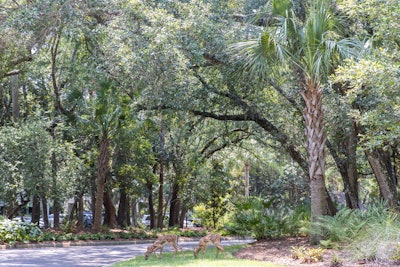
With winter here, now is the time to think about protecting your clients' landscapes from animals. During the winter, when food becomes increasingly scarce for animals, they become more likely to wander onto your clients' properties in search of a meal. In areas where there is an abundance of wildlife, this can become incredibly problematic as animals like deer can very swiftly decimate an entire landscape.
It's important to take steps to prevent animal damage in order to protect your clients' beloved plants.
In Montana, wildlife damage is a common problem, so Blanchford Landscape Group based in Bozeman is always looking at creative solutions.
According to Andrew Blanchford, the company owner, it's not just the animals feasting that poses a problem. Various wildlife like moose, elk, and deer can also trample plants as they pass through. And, some animals rub their antlers on the trees which strips away the cambium and causes a severe injury.
"The solutions can differ depending upon the region," Blanchford says. "In some areas, the wildlife might be so desperate for food that they'd easily rip apart a fence. But if it's an area where there is other food available around the perimeter, a simple trunk wrap could be enough. We have to analyze each situation and devise the best solution."
In areas where fencing is a viable option, it should be at least eight feet tall and sturdy. Animals have been known to jump (or crash through) fences when they are motivated for food. Some shrubs might be wrapped to prevent animal damage (and also protect them from harsh winter weather).
Choosing wildlife-resistant plants
Another way to prevent wildlife damage on your clients' properties is to choose plants that the animals tend to avoid. For example, selecting deer-resistant plants (plants that they typically don't like to eat) can help keep the deer away.
This is a strategy that Yellowstone Landscape, a commercial landscaping company headquartered in Bunnell, Florida, has employed at a number of locations. But Joseph Barnes, marketing director for the company, is quick to point out that there is no such thing as a 100-percent "deer-proof" plant.
If a deer is hungry enough, it will overcome its distaste for a plant. But you can still make selections that the deer will be less likely to eat.
Generally speaking, deer might not like a particular plant due to a bitter taste, a strange texture, or a foul smell. Some options that tend to be deer-resistant include the following.
- Elderberry
- Mint
- Fountain Grass
- Spirea
- Juniper
- Peonies
- Salvia
- Zinnia
- Echinacea
While not completely deer-proof, these choices are at least less likely to be consumed. Being smart about plant location is also important.
"Perimeter areas of a landscape, which border the natural habitat, are the most prone to deer problems," adds Barnes.
Being a problem-solver for your clients
At the end of the day, your help in preventing animal damage to your clients' landscapes will help to position you as a problem solver, which is a valuable role. Your clients look to you as an expert and you can help set them up for success by implementing animal damage solutions whenever possible.











